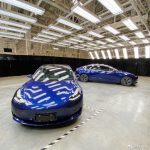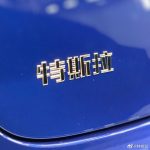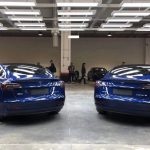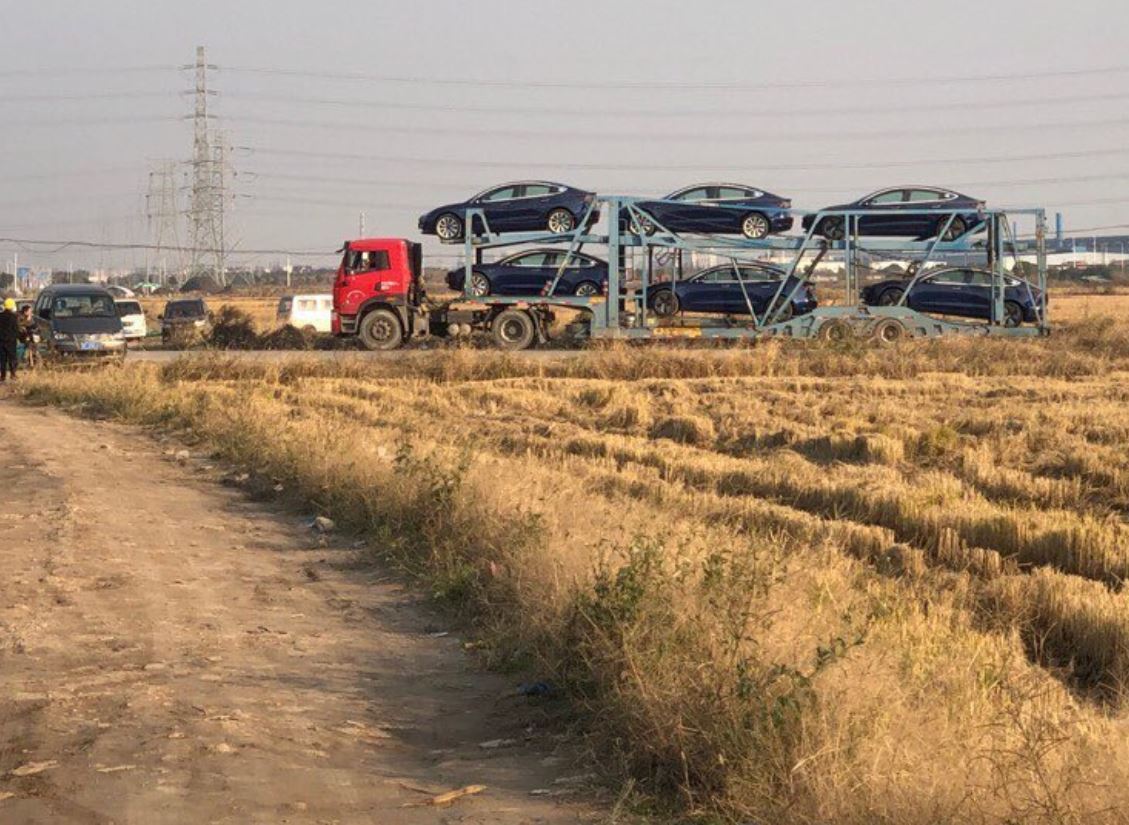
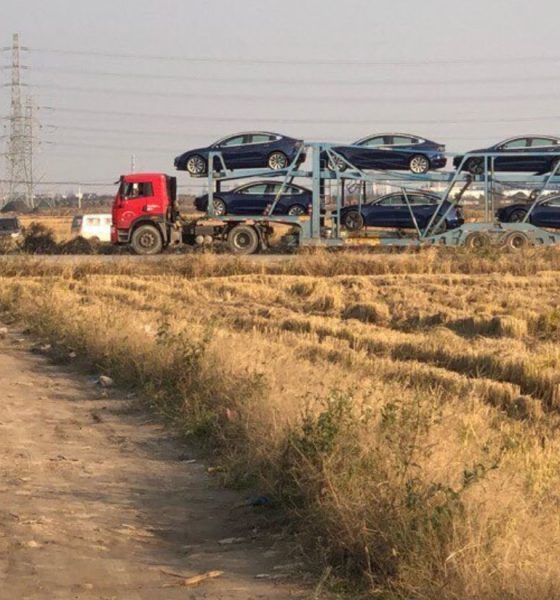
News
Tesla Made-in-China Model 3 first deliveries imminent as carriers spotted leaving Gigafactory 3
Transport trucks carrying Tesla’s Made-in-China Model 3 were spotted leaving the company’s Gigafactory 3 production facility in Shanghai, presumably on their way to customer delivery centers.
The sighting comes on the heels of Tesla’s inclusion in the list of electric vehicles that qualify for government incentives and the official green light for the company the sell and deliver its cars within the country.
Tesla owner JayinShanghai visited the China factory and posted several images of car trailers hauling Made-in-China Model 3 units out of the factory.
Tesla Owner in Shanghai visits Shanghai Gigafactory 3 today to find out that they are transporting Made in China Model 3 to Delivery center across China 🇨🇳. Posted on 小特APP @xiaoteshushu #Tesa #TeslaChina #gigafactory #GF3 #China #特斯拉 #中国 $TSLA pic.twitter.com/FneGqqCHV7
— Jay in Shanghai 电动 Jay 🇨🇳 (@JayinShanghai) December 7, 2019
Tesla’s initial estimation for the first deliveries of the China-made Model 3 was late January 2020. But having received the permit to sell its locally-produced Model 3 sooner than expected, Tesla can begin its Model 3 push into the biggest automotive market in the world that’s aiming to have 25% of its car sales comprised of electrified vehicles by 2025.
Tesla’s entry into the Chinese electric vehicle market is seen as positive development even among local competition such as Xpeng Motors. President Brian Gu sees the brand serving as a catalyst in the domestic electric vehicle market and would pave the way for a better supply chain and experience for customers.
“I always believe that having a good product that really gets the consumer interested and expands the overall market is good for the industry,” Gu said.
Tesla has 24 stores in China as listed on its website and plans to expand its after-sales network by doubling the number of its maintenance shops to 63 from 29, add 100 more fast-charging stations and turn some showrooms in the country into one-stop-shop Tesla Centers.
Two Tesla Model 3 variants were included in the list of new electric vehicle incentives released by China’s Ministry of Industry and Information Technology, giving consumers at least $3,550 of savings when they purchase the locally-produced Model 3.
Days prior to receiving the official green light to sell Made-in-China Model 3 vehicles, sightings of Model 3 inventory painted a clear picture that the electric carmaker was preparing for first customer deliveries.
Tesla China also announced that its executives have opened Weibo accounts – a popular social media platform in China – to ensure customers can communicate with the management team directly.
Tesla China senior executives collectively opened Weibo accounts and linked to Tesla China Weibo homepage. It ensures Tesla users and fans to directly communicate with management team in a timely manner, as Elon mentioned: "Speed solves everything.” pic.twitter.com/gjtYQfwyDn
— Tesla Asia (@Tesla_Asia) December 8, 2019
- Tesla’s Made-in-China Model 3. (Credit: JayInShanghai/Twitter)
- Tesla’s Made-in-China Model 3. (Credit: JayInShanghai/Twitter)
- Tesla’s Made-in-China Model 3. (Credit: JayInShanghai/Twitter)

Elon Musk
Elon Musk and Tesla AI Director share insights after empty driver seat Robotaxi rides
The executives’ unoccupied tests hint at the rapid progress of Tesla’s unsupervised Robotaxi efforts.

Tesla CEO Elon Musk and AI Director Ashok Elluswamy celebrated Christmas Eve by sharing personal experiences with Robotaxi vehicles that had no safety monitor or occupant in the driver’s seat. Musk described the system’s “perfect driving” around Austin, while Elluswamy posted video from the back seat, calling it “an amazing experience.”
The executives’ unoccupied tests hint at the rapid progress of Tesla’s unsupervised Robotaxi efforts.
Elon and Ashok’s firsthand Robotaxi insights
Prior to Musk and the Tesla AI Director’s posts, sightings of unmanned Teslas navigating public roads were widely shared on social media. One such vehicle was spotted in Austin, Texas, which Elon Musk acknowleged by stating that “Testing is underway with no occupants in the car.”
Based on his Christmas Eve post, Musk seemed to have tested an unmanned Tesla himself. “A Tesla with no safety monitor in the car and me sitting in the passenger seat took me all around Austin on Sunday with perfect driving,” Musk wrote in his post.
Elluswamy responded with a 2-minute video showing himself in the rear of an unmanned Tesla. The video featured the vehicle’s empty front seats, as well as its smooth handling through real-world traffic. He captioned his video with the words, “It’s an amazing experience!”
Towards Unsupervised operations
During an xAI Hackathon earlier this month, Elon Musk mentioned that Tesla owed be removing Safety Monitors from its Robotaxis in Austin in just three weeks. “Unsupervised is pretty much solved at this point. So there will be Tesla Robotaxis operating in Austin with no one in them. Not even anyone in the passenger seat in about three weeks,” he said. Musk echoed similar estimates at the 2025 Annual Shareholder Meeting and the Q3 2025 earnings call.
Considering the insights that were posted Musk and Elluswamy, it does appear that Tesla is working hard towards operating its Robotaxis with no safety monitors. This is quite impressive considering that the service was launched just earlier this year.
Elon Musk
Starlink passes 9 million active customers just weeks after hitting 8 million
The milestone highlights the accelerating growth of Starlink, which has now been adding over 20,000 new users per day.

SpaceX’s Starlink satellite internet service has continued its rapid global expansion, surpassing 9 million active customers just weeks after crossing the 8 million mark.
The milestone highlights the accelerating growth of Starlink, which has now been adding over 20,000 new users per day.
9 million customers
In a post on X, SpaceX stated that Starlink now serves over 9 million active users across 155 countries, territories, and markets. The company reached 8 million customers in early November, meaning it added roughly 1 million subscribers in under seven weeks, or about 21,275 new users on average per day.
“Starlink is connecting more than 9M active customers with high-speed internet across 155 countries, territories, and many other markets,” Starlink wrote in a post on its official X account. SpaceX President Gwynne Shotwell also celebrated the milestone on X. “A huge thank you to all of our customers and congrats to the Starlink team for such an incredible product,” she wrote.
That growth rate reflects both rising demand for broadband in underserved regions and Starlink’s expanding satellite constellation, which now includes more than 9,000 low-Earth-orbit satellites designed to deliver high-speed, low-latency internet worldwide.
Starlink’s momentum
Starlink’s momentum has been building up. SpaceX reported 4.6 million Starlink customers in December 2024, followed by 7 million by August 2025, and 8 million customers in November. Independent data also suggests Starlink usage is rising sharply, with Cloudflare reporting that global web traffic from Starlink users more than doubled in 2025, as noted in an Insider report.
Starlink’s momentum is increasingly tied to SpaceX’s broader financial outlook. Elon Musk has said the satellite network is “by far” the company’s largest revenue driver, and reports suggest SpaceX may be positioning itself for an initial public offering as soon as next year, with valuations estimated as high as $1.5 trillion. Musk has also suggested in the past that Starlink could have its own IPO in the future.
News
NVIDIA Director of Robotics: Tesla FSD v14 is the first AI to pass the “Physical Turing Test”
After testing FSD v14, Fan stated that his experience with FSD felt magical at first, but it soon started to feel like a routine.

NVIDIA Director of Robotics Jim Fan has praised Tesla’s Full Self-Driving (Supervised) v14 as the first AI to pass what he described as a “Physical Turing Test.”
After testing FSD v14, Fan stated that his experience with FSD felt magical at first, but it soon started to feel like a routine. And just like smartphones today, removing it now would “actively hurt.”
Jim Fan’s hands-on FSD v14 impressions
Fan, a leading researcher in embodied AI who is currently solving Physical AI at NVIDIA and spearheading the company’s Project GR00T initiative, noted that he actually was late to the Tesla game. He was, however, one of the first to try out FSD v14.
“I was very late to own a Tesla but among the earliest to try out FSD v14. It’s perhaps the first time I experience an AI that passes the Physical Turing Test: after a long day at work, you press a button, lay back, and couldn’t tell if a neural net or a human drove you home,” Fan wrote in a post on X.
Fan added: “Despite knowing exactly how robot learning works, I still find it magical watching the steering wheel turn by itself. First it feels surreal, next it becomes routine. Then, like the smartphone, taking it away actively hurts. This is how humanity gets rewired and glued to god-like technologies.”
The Physical Turing Test
The original Turing Test was conceived by Alan Turing in 1950, and it was aimed at determining if a machine could exhibit behavior that is equivalent to or indistinguishable from a human. By focusing on text-based conversations, the original Turing Test set a high bar for natural language processing and machine learning.
This test has been passed by today’s large language models. However, the capability to converse in a humanlike manner is a completely different challenge from performing real-world problem-solving or physical interactions. Thus, Fan introduced the Physical Turing Test, which challenges AI systems to demonstrate intelligence through physical actions.
Based on Fan’s comments, Tesla has demonstrated these intelligent physical actions with FSD v14. Elon Musk agreed with the NVIDIA executive, stating in a post on X that with FSD v14, “you can sense the sentience maturing.” Musk also praised Tesla AI, calling it the best “real-world AI” today.
